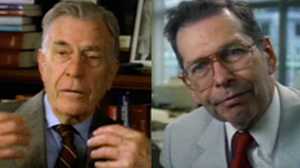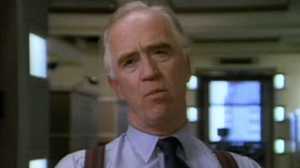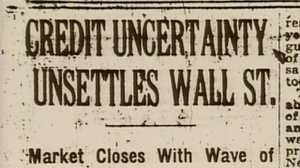Interview: Stock Exchange Clerks

Tom McCormick, stock sales clerk, 1929
Trinity and Greenwich, between them on James Street, they had these little red-brick buildings, old buildings… There was a speakeasy in there. You’d walk in. It was up one flight. And he had a couple of desks, one desk… the dust was that thick on them. And in the back he made his gin. You know, bathtub gin. I was only a kid at the time and I was working on doing bookkeeping with these two older fellows, bookkeepers. So every night they’d send me over there with a dollar, to get a fifth of gin. I’d go over, walk in. “What do you want?” “Fifth of gin.” “What do you want, Gilbeys or some…” Didn’t matter what. Just put any label, any label you ask, it was the same gin. This I’d bring back. These two fellows I worked with. One of them was a graduate of Rutgers and the other one was a graduate of Fordham. And they had been football players, they were big, heavy…. they’d be sitting in the front office with their feet up and they’d be drinking the gin. And the other kid and I, we’d be out there doing the bookkeeping. Writing up the books…
These blotters that they used to send down to the clearinghouse, night clearing. If the handwriting wasn’t very legible, real good — in fact, they took the best hand writer to write them up — they’d turn around and send it back to you. And they’d fine you. They would fine you for writing it wrong. If you’d have made a mistake, one of the figures, five dollar fine. You got your sheet and you had to balance your sheet at the end of the day and send it down to them and they’d take all these sheets from all the houses, put them together and they’d pair off all the trades. So in other words, if you sold 500 shares of Telephone and you bought 400, you know, on the buy side, you would be delivering 100, they paired them all off, four against the five. So you were selling one. That was … how could I put it? That was like the computer we have today. Cutting down on the work.

Horace Silverstone, New York Stock Exchange telephone clerk, 1929
In October of 1929 I was just being broken in on the phones on the floor of the Stock Exchange, cold. The wires from the order room and from any special customer or any registered rep that had a direct wire to me, would put an order in and I had to take the order — buy a thousand shares of Auburn Motors or whatever. Give it to a broker. But at that time I was just a clerk. I was brought down two months before that crash took place to learn the wires. So when the crash took place, I didn’t know enough about what was going on. And it was just like a nightmare. I couldn’t believe what was going on. In those days, every buy order was on a black pad. And every sell order was on a red pad. And all I saw was members running around with a fistful of red orders. I couldn’t find any bids. I’d come back to the phone and say, “there’s no bid for New York Central, it’s down … it’s selling down 15 points.” The tape ran … in those days the market was open from 10 until 3. That’s during the five day week and on Saturday, from 10 to 12 on Saturday, we had a short weekend. Anyhow, the tape ran two and a half hours late in a five-hour session and didn’t stop running until 8:30 at night the day of the crash.

Reuben L. Cain, stock salesman, 1929
I really went to look for a job on Wall Street hoping that I could make money… You’d heard so much about the bull market and the way everything was going up… and read about such people as Charlie Mitchell, the president of National City Bank, and a lot of others — the J. P. Morgan group — and they seemed to be so strong and so powerful and knew so much about the market that, as they kept saying “This is going to correct itself,” you tended to believe them. And then when it did fall, you still couldn’t hardly believe it fell.
There were all sorts of rumors and you’d see people going down the street looking up to see if they could catch somebody jumping out the window. Now it turned out there weren’t as many people jumped out the window as they reported, but some did. And others committed suicide other ways.








